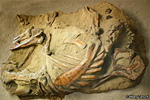

Dinosaur Provincial Park |
|||||||||||||
Location: Red Deer River valley, southeast Alberta, Canada Time: 76.7 to 74.9 million years ago, during the Cretaceous period About this Famous Find: The spectacular badlands at Dinosaur Provincial Park contain one of the most important assemblages of late Cretaceous fossils in the world. The richness, diversity and quality of these fossils contributed to the park being declared a UNESCO World Heritage Site in 1979. The park's 80 square km have yielded 42 species of dinosaurs, more than 90 other vertebrates, as well as numerous invertebrates and plant fossils (mostly pollen grains and spores). The abundance and quality of these fossils have given scientists an unparalleled glimpse into the paleoecology of ancient Alberta from about 75 million years ago. Three geologic formations, each representing a distinct paleoenvironment, are visible in Dinosaur Provincial Park: The Oldman Formation: The lowest unit of visible bedrock belongs to the Oldman Formation and is characterized by hard, tan-coloured, fluvial sandstone deposits which formed in braided streams. The Oldman shows evidence of an inland paleoenvironment with seasonal wet and dry variability; where ancient rivers flowed with flash floods and then dried up completely. The 30-metre-thick section of Oldman Formation in the park produces large numbers of isolated dinosaur bones, although almost no articulated specimens have been found. The Dinosaur Park Formation: At 80 metres thick, the Dinosaur Park Formation comprises the bulk of locally exposed bedrock. Its smooth grey sandstones and green-tinged mudstones provide evidence of a much wetter fluvial and coastal plain environment, when the landscape was dotted with ponds and swamps and bisected by wide, deep, meandering rivers with high sediment loads. The Dinosaur Park Formation is one of the richest dinosaur-fossil-bearing strata in the world. The unit has produced a number of exquisite articulated dinosaur specimens, but is also known for its high density of single bones and dinosaur bonebeds, especially of ceratopsians. In addition to dinosaurs, many other vertebrates are represented, such as turtles, crocodiles, champsosaurs, marsupial and multituberculate mammals, and freshwater fishes, along with scattered remains of amphibians, aquatic birds, and pterosaurs. The Bearpaw Formation: The uppermost rock unit in Dinosaur Provincial Park is the Bearpaw Formation, deposited when the Western Interior Seaway invaded from the east. This 10-metre-thick section is comprised of marine-based mudstones and shales, so dinosaur specimens are virtually absent. Fossil finds are typically limited to invertebrates such as ammonites and baculites, but vertebrates including sharks, mosasaurs and plesiosaurs have also been found. Dinosaur genera found in the park include Brachylophosaurus, Centrosaurus, Chasmosaurus, Chirostenotes, Corythosaurus, Daspletosaurus, Dromaeosaurus, Edmontonia, Elmisaurus, Euoplocephalus, Gorgosaurus, Gryposaurus, Hesperonychus, Lambeosaurus, Leptoceratops, Ornithomimus, Panoplosaurus, Parasaurolophus, Prosaurolophus, Ricardoestesia, Saurornitholestes, Stegoceras, Struthiomimus, Styracosaurus, and Troodon. Resources
|
|
site tour |
about the site |
site map |
site credits |
page credits |
help |
FAQs |
contact |
||

